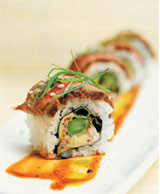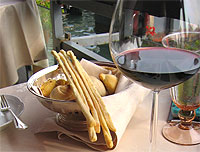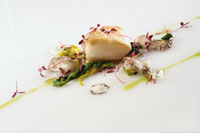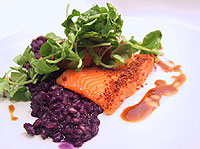|
The
Rise of Fusion Foods and Wines
by
Randal Caparoso
 |
| Roy
Yamaguchi's Lakanilau Roll |
In
the early 1990s a well-meaning consumer had the temerity to take
some of Hawaii's new fusion chefs to task in the editorial pages
of one of Honolulu's daily newspapers.
"Pacific Rim food is over-done," he opined. "Fusion
cooking... a ridiculous experiment gone awry... bizarre... complicated...
frou frou!"
Although I personally worked with, and encouraged, pretty much the
best of Hawaii's fusion chefs, I can't say that I found those comments
particularly hurtful. For one thing, it was often true; new Island
cooking could be bizarre. Then again, this was the kind of cooking
that captured the fancy of Island visitors and locals alike -- not
to mention the lion's share of international press - and it would
have been foolish for even modestly talented chefs and restaurateurs
not to incorporate these new ideas.
It's All Fusion!
 |
The
ironic thing, as most food culturists observe, is that there is
virtually no cuisine in this world that does not represent some
kind of fusion. The Italian cooking that we know today has evolved
at an incredible pace since the 19th century, influenced by foodstuffs
and techniques borrowed from all over the Mediterranean, and from
faraway as China and America. The various cuisines of India, China,
Thailand, Vietnam, and throughout Asia grew from cultures of people
utilizing everything at their disposal, including all they could
absorb from neighboring countries and cultures.
In American shopping malls, sushi, spring rolls, strudel, pizza,
pierogi, falafel, rellenos and Polish dogs are sold side by side
with nary a blink; and there's a good reason why many of these foodstuffs
bear little resemblance to foods of the same name in their original
countries: they've been thoroughly melted, or Americanized, into
a larger pot. And it is always a matter of time before foods begin
to "fuse" into something different, to the point where
the untraditional becomes something of an "old" tradition…
or so it always seems.
What I found particularly interesting about the occasional criticism
of Hawaii's evolving cuisine was the degree of response to similar
developments in other parts of the world. When I first visited Australia
in 1992, for instance, I expected to find classy wine and maybe
some classically defined foods with an Anglo-Aussie bent. Instead,
what I found was scores of well trained, disciplined chefs applying
a host of East-West, North-South, cross-cultural approaches to an
enviable range of meats, seafoods, and produce for a justifiably
proud and appreciative populace. And why not? For a country once
known for little beyond roast lamb and a black yeast paste called
vegemite, dishes like Tasmanian rock oyster in ginger black bean
beurre blanc, or wallaby roulade with native warrigal spinach chips,
amount to exciting progressions in imagination and regional self-realization.
Modern British Cuisine. Gastronomic Plagiarism?
|
Poured
soup with star anise by Michel Roux |
At
the same time on the opposite side of the globe, Californian, Asian,
and Mediterranean influences came together to form an even more
peculiar culinary movement known as Modern British Cuisine. A Decanter
magazine once quoted one of its ringleaders, Anthony Worral Thompson,
to say, "Most Modern British chefs have trained at a serious
French level and gained a good understanding of food, what works
together and how it works, and when you've got that you can experiment."
Basically, according to Thompson, this movement grew out of a "plundering"
of ideas and ingredients—Thai spices, Japanese soy, Irish oysters,
Italian Parmesan, French truffles, Old English puddings, Baltic
herring, etc.—until it became only "a question of time
before 'theirs' becomes 'ours.'" Call it progress, or gastronomic
plagiarism—the important thing for Thompson was that it was
"great to have an identity and restaurants we can be proud
of."
Sound familiar? In disparate places, a building upon different (or
indifferent) traditions, bringing new levels of culinary self-respect
and resulting commercial success.
So are the world's newly defined "regional" cooking styles
half-baked or over-done? I'm not sure if either is possible. While
perhaps not as eclectic as Hawaii, virtually the entire North American
continent is, after all, a melting pot. Americans have never really
needed to "plunder" other traditions; they live and breathe
them as we speak. I recently saw a book on Southern Appalachian
cooking called Smokehouse Ham, Spoon Bread & Scuppernong
Wine that described itself as "a celebration of foodlore
handed down from Scotland, England, Ireland, Germany and the Cherokee
Nation." If that's not fusion cooking, I don't know what is.
Dramatic cultural crossings beyond previously known bounds have
been the norm for such a long time, we'd be remiss if we didn't
celebrate it!
From the wine perspective, the cultural and commercial ramifications
associated with the latest and most visible culinary variations
have resulted in two things:
•
A stronger need to expand our taste for globally sourced wines to
match this growing culinary diversity.
• Gravitation towards wines tailored towards new foods rather
than just for power, finesse, regional or varietal definition, big
scores, or any other factors.
"Fangled"
Foods Require Fangled Grapes
If
you've looked at the wine lists in some of today's hipper restaurants,
you are already aware of the astounding range of wines now being
aggressively merchandised alongside the usual Cabernet Sauvignons
and Chardonnays: Teroldego from Trentino, Riesling Halbtrocken from
the Saar, Spätburgunder from the Pfalz, Blaufränkisch
from Austria and Columbia Valley, Cabernet Franc from Chinon and
Bourgueil, Malbec from Cahors and Mendoza, and Grenache, Syrah,
Mourvèdre, Roussanne, Marsanne and Viognier from everywhere
from McLaren Vale to Edna Valley, Maipo in Chile, Jumilla in Spain,
the traditional Rhone and the vast expanse of the Languedoc-Roussillon.
So why are restaurateurs subjecting consumers to such new fangled
regions and grapes? It's easier to understand when you know why
they're needed: to match new fangled foods. Emerging styles of fusion
cooking can be bewilderingly varied—utilizing Thai spices,
Japanese seasonings, Chinese vegetables, Italian herbs, and French
style sauce reductions, often in one dish! In these contexts, even
the most unusual wines become, well, usual.
So here are some observations on such new complications, along with
a few remedies:
New
fusion cooking is often tilted towards chile spices and other hot
sensations resulting from use of peppers, curries, shichimi
(Japanese "seven-spice"), wasabi, rayu (spicy sesame
oil), sriracha (Vietnamese and Thai chili pastes), kung pao
(Chinese chili sauce), and peppercorns. These are often combined
with salty, sweet and sour ingredients such as soy, miso, hoisin,
lemon grass, pickled ginger, green papaya, coconut milk, oyster
sauce, mirin (sweet Japanese rice wine), seaweeds, shrimp
pastes (such as bagoong), fish sauces (patis and nuoc
mam), as well as fruit and/or palm sugar infused marinades and
pronounced shellfish stock reductions.
 |
While
not exactly classic matches for red Bordeaux and white Burgundy
varietal types, more and more Americans are beginning to appreciate
such ingredients as being classical in their own right; and are
looking for wines to go with them. Clearly, hot, salty, sweet and
sour sensations are more easily assimilated by either slightly sweet,
fruity whites balanced by fairly crisp acidity (Riesling or Loire
River grown Chenin Blanc), perceptively tart, dry whites (dry style
Rieslings and Pinot Gris), or fairly light, lively, soft tannin
reds (Pinot Noir, Lemberger, Cabernet Franc, and some Sangioveses
and easier styles of Syrah) and pinks with lightly acidic edges
(especially vin gris of Pinot Noir, Sangiovese, or multiple varietal
blends).
The operative terms are lightness (moderated alcohol), tartness
(favoring combinations of higher acid varietals and cold climate
vineyards), and fruitiness (especially in lower tannin reds). But
it is possible to overemphasize the factors of size, acidity, and
even varietal fruitiness. For instance, in spicy hot food settings,
Gewurztraminer, Viognier, and Muscat—varietals that are commonly
lauded for their "spice" components—can be poor performers
because of their propensity towards bitter phenolics and hot tasting
alcohol levels, especially when fermented dry. Yet the sweet, spicy
fruitiness of even the biggest, thickest Australian Shiraz often
works with chili or wasabi laced dishes. In the latter case, when
spice components in a high fat/protein meat dish are smartly balanced
by sweet, salty and/or sour ingredients, a good sized Shiraz (or
even Cabernet Sauvignons laced with Shiraz) can be made to taste
even lusher and "sweeter"—always a pleasing surprise!
By the same token, while you would expect light, zesty, sweetly
scented Sauvignon Blancs and Pinot Gris to work easily with spicy
dishes, they are often too severe in their acidity or neutral in
their dryness to make more than an "okay" match; lacking,
say, the positively floral, tropical fruit qualities that an off-dry
or dry Riesling may bring to a plate.
The same thing with Merlot and even Gamay: although their tannin
levels may be low enough, they usually lack the spice and fruit-forward
dimensions that make Pinot Noir, Cabernet Franc, and even fairly
tannic Zinfandel and Syrah based reds such easy fits with aggressively
spiced foods. Fusion food friendly reds are not defined by soft
tannin alone.
| Softer
Textured White Fish
and Sweet-Meaty Shellfish |
 |
| A
light fish creation at The Jackson House Inn & Restaurant
|
Softer
textured white fish and sweet-meaty shellfish of all types set in
the context of milder (sans heat) spices, and often tropical fruit,
coconut milk, soy sauce, aggressively Asian seasonings (such as
kaffir lime, cilantro, Chinese five-spice, mirin, fish sauces, star
anise, and licorice basils), slightly bitter vegetables (mesclun,
eggplant, Chinese mustards and cabbages, etc.), and even traditional
Mediterranean elements (balsamics, oils, tomato, basil, etc.) tend
to be diametrically opposed to all but the most crisp and subtle
Chardonnay based whites. We have usually found far easier matches
in, say, crisp-edged, moderately weighted dry whites such as Pinot
Gris (or Pinot Grigio), Albarino, Cortese, Picpoul, Sauvignon Blanc,
and of course, Riesling.
To the extent that many fusion style preparations of fish are finished
with oils and vinegars rather than butter or cream, even mildly
acidic, more densely structured or fuller alcohol white varietals—particularly
Pinot Blanc, Tocai Friulano, Gruner Veltliner, Fendant, Marsanne,
Roussanne, Grechetto, Viognier, Semillon, and the great variety
of blends thereof (Marsanne/Roussanne, Marsanne/Viognier, Chardonnay/Grechetto,
Semillon/Sauvignon Blanc, Chardonnay/Semillon, et al.)—can
be quite successful. One of the keys to these matches is moderate
use (or else non-use) of oak, which can be frivolous in the context
of Asian influenced fish dishes; in which case, pronounced fruitiness
and complexity of aroma/flavor (terroir, mineral, floral and spice
nuances) can easily accomplish the task of assimilating variant
food sensations.
 |
| Wild
King Salmon at wd-50 |
The
meaty, fleshy qualities of fish such as tuna (especially Hawaiian
ahi), salmon, and swordfish in Asian influenced contexts usually
make such foods more suitable to lighter, lower tannin reds than
to whites. This has led to the presence of many styles of Pinot
Noir, Cabernet Franc, Sangiovese, and Syrah on our wine lists; extending
out to less familiar yet unique, interesting types such as Tempranillo
from Spain, Dolcetto from Piemonte, Zweigelt and Blaufränkisch
from Austria, lusher styles of Grenache from Australia and France
(such as Gigondas and Vacqueyras), and the occasional old-vine,
own-rooted Carignane from South-West France, Spain or California.
While not entirely present in every wine, the key components in
most of these red-wine-with-fish matches are rounded tannins, moderate
acidity, and pronounced fruit/spice qualities. Imbued with one combination
or another, red wines that enter the palate a little more softly
tend to carry a much bigger stick in fleshier fusion fish contexts.
| Less
Fatty Cuts of Meat, Poultry and Game |
The
growing and more judicious use of less fatty cuts of beef, lamb,
pork, poultry and game in Asian-influenced settings—often involving
marinades, braising (toward caramelized sensations), and/or natural
stock reductions infused with ingredients like soy, ginger, garlic,
star anise, tamarind, scallion, palm sugar, lemon grass, cilantro,
curry, coconut milk, tropical fruits, syrups, vinegars, and plum
pastes—are particularly apropos with lower tannin or sweetly
fruited reds of virtually all types. This would include varietal
types such as Pinot Noir, Merlot, Cabernet Franc, Tempranillo, Syrah,
Grenache, and Sangiovese.
It
also leaves room for the great variety of blends that portray rounded,
juicy fruit ("suggesting" sweetness without actual residual
sugar) as well as exotic spice/pepper/herbal/smoky qualities over
sheer power and structure. In fact, not just in the classic Grenache/Syrah/Mourvèdre,
Cabernet/Shiraz, Sangiovese/Cabernet Sauvignon (i.e. Tuscany), or
Tempranillo/Grenache (Ribera del Duero) blends, but also in some
of the more imaginative (even if bewildering) combinations found
in contemporary wines. For example:
•
Cabernet Franc/Merlot (such as Justin's Paso Robles Justification)
• Sangiovese/Syrah (found in Swanson's Napa Valley Sangiovese)
• Sangiovese/Merlot/Cabernet Sauvignon (Falesco Vitiano
in Italy's Umbria)
• Zinfandel/Merlot/Cabernet Sauvignon (Duckhorn's Napa Valley
Paraduxx)
• Merlot/Pinot Noir (Sportoletti's Villa Fidelia in
Italy's Assisi)
• Malbec/Merlot (Domaine Pineraie in Cahors, France)
• Mourvèdre/Merlot/Tempranillo (Carchelo in Spain)
• Tempranillo/Cabernet Sauvignon (Spain's Abadia Retuerto)
• Cabernet Sauvignon/Gaglioppo (Librandi's Gravello
in Italy's Calabria)
• Carmenere/Merlot/Cabernet Sauvignon (Veramonte's Primus in
Chile)
• Syrah/Cabernet Franc/Cabernet Sauvignon (Fox Creek's JSM
from McLaren Vale)
• Blaufränkisch/Cabernet Sauvignon/Zweigelt/Merlot (Pichler's
Arachon Evolution in Austria)
You
can, in fact, see these and increasingly more imaginative blends
everywhere you go. They exist for good reasons: great commercial
appeal, plus rapid expansion of food needs.
The
bottom line is that fusion style chefs around the world are cooking
up a storm. This style of cuisine is alive and kicking, and a mark
of sophistication; and consumers are responding accordingly. We
are all just beginning to understand how wines can successfully
compliment these new fusions. The possibilities are probably endless,
and as varied as our evolving definitions of wine quality and appreciation.
*
Chili peppers image from www.chilepepperinstitute.org
* Michel Roux dish image from Michel
Roux: New Creative Techniques from a French Master Chef
© Randal Caparoso
|
